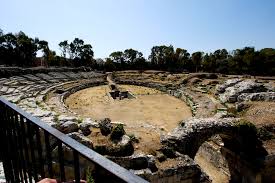Presento in questa sede un articolo che avevo scritto in inglese sul Teatro Thing. Il Nazional Socialismo, per avvicinare le masse all’ideologia nazista, inventò una nuova forma di teatro, chiamata appunto Teatro Thing . Nel progetto di fondazione del teatro popolare nazionalsocialista, il termine Thing si riferiva essenzialmente alla struttura del teatro, fatta ad anfiteatro, mentre la scenografia ricalcava un po’ le forme del teatro medievale, che effettivamente possedeva un forte carattere popolare. Infatti, nel Medioevo, di solito le scene erano situate all’interno delle chiese, oppure su carri trainati da buoi, che andavano in giro per il paese.
National Socialism established a new form of theatrical expression, called Thing theater, in order to bring the people closer to Nazi ideology. The word Thing derives from the Old high German language, and it seems it has been used to refer to the early German Assembly. According to Tacitus (Germania, 11-12), the German Thing “took place during a new or full moon, both considered to be good omens.” (M. M. Winkler). The term Thingspiel was invented by Professor Carl Niessen (Cologne University) who asserted that words like thing and Thingspiel refer “to a place where Germanic tribes would gather, probably under sacred oak-trees, to hold political meeting and tribunals.” (Erika Fischer-Lichte). Besides, the word Thing labeled circular amphitheaters, i.e. the open-air rings where the old Germans gathered around their chiefs.
The scene design followed the Old medieval theatre structures, which had a strong popular accent. In the Middle Ages usually the scenes were represented in the interior of the churches or on wagons drawn by oxen. The Medieval theatre was a very successful popular theatre, where plays were performed for a large number of illiterate people. Given this scope, the Middle Ages was particularly important in the Nazis Thing plays, where local dialects and regional languages were frequently employed for propaganda purposes. Usually the Thing Theaters were built in natural settings, and often in locations of mythical importance like on top of forested hills, near ruined abbeys, among rocks, and oak trees.
Evoking Germanic legends, there were soldiers as heroic figures, knights of high birth, and former German emperors of exceptional qualities. Other characters within the Thing Theatre were gods and goddesses, like Odin and Thor, princesses with wonderful magical powers, men and women transformed into beasts, and, around them, the fabulous mountains of immortality, and of eternal youth. If not immortality (which seems to be too for anybody), at least eternal youth seems feasible also today thanks to miraculous creams, such as tanner, cleansing, beauty, hand, face, and sun creams.
But let’s be serious, because it’s a critical moment. The Thing Theatre was very successful during the Nazi period, and “by the end of 1934 five stages were finished […] These stages were usually the focal point of vast outdoor theaters to accommodate thousands of people. The Thingplatz auditorium in Braunschweig could hold 15,000 and at Annaberg up to 50,000 people.” (W. Niven). Goebbels knew the potential of theatre and used it for his purposes of propaganda.
Theater, as we know it, may be serious or humorous, and I can say that the experience of the Thing Theatre shows again and again how the mass society is open to all sorts of manipulations. It is sufficient to invest a certain sum in the project, and one might say that, yes, even donkeys can fly.
Why?
Simply because on the great (Thing) theatre of the mass society human being is reduced to simple things, which “cerebrum non habe[n]t” ( which have not brain) [Phaedrus].
« Quid rides? mutato nomine de te Fabula narratur. » (Horace).
Why do you laugh? Change, but the name and the story is told of yourself.
Sources:
M. M. Winkler, “From Roman History to German Nationalism: Arminius and Varus in Die Hermannschlacht,” in The Ancient World in Silent Cinema, edited by P. Michelakis-M. Wyke, Cambridge University Press, 2013, p. 307 and footnote 15.
Erika Fischer-Lichte, “Theatre in the Third Reich: between Thingspiel and the Classics,” In ASSAPH. Studies in the theatre, Tel Aviv University, 1997, p. 178.
W. Niven, “The Birth of Nazi’s Drama? Thing Plays,” Edited by J. London, in Theatre Under the Nazis, Manchester & New York, Manchester University Press, 2000, p. 56.
